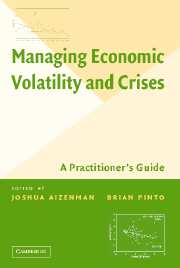Book contents
- Frontmatter
- Contents
- Contributors
- Acknowledgments
- Foreword
- MANAGING ECONOMIC VOLATILITY AND CRISES
- Overview
- PART I WHAT IS VOLATILITY AND WHY DOES IT MATTER?
- PART II COMMODITY PRICES AND VOLATILITY
- PART III FINANCE AND VOLATILITY
- 6 Finance and Volatility
- 7 Evaluating Pricing Signals from the Bond Markets
- PART IV MANAGING CRISES
- Technical Appendix
- Index
- References
7 - Evaluating Pricing Signals from the Bond Markets
Published online by Cambridge University Press: 25 July 2009
- Frontmatter
- Contents
- Contributors
- Acknowledgments
- Foreword
- MANAGING ECONOMIC VOLATILITY AND CRISES
- Overview
- PART I WHAT IS VOLATILITY AND WHY DOES IT MATTER?
- PART II COMMODITY PRICES AND VOLATILITY
- PART III FINANCE AND VOLATILITY
- 6 Finance and Volatility
- 7 Evaluating Pricing Signals from the Bond Markets
- PART IV MANAGING CRISES
- Technical Appendix
- Index
- References
Summary
ABSTRACT: This study analyzes emerging market yield spreads, utilizing a step-by-step approach designed to be accessible to a general audience including policy specialists, market practitioners, and debt market students. The discussion highlights the roles of investor perceptions regarding the probability of bond default and default-state recovery value in bond valuation. The core framework for interpreting yield spreads as signals of default probabilities is developed within a series of examples. These examples reflect the important effects of alternative recovery value assumptions on yield spreads. First, the standard sovereign spread computation is related to per period default probability under the special assumption of zero-percent recovery of face value in default. Next, the “stripped” sovereign spread concept – applicable to issues like Brady bonds that have 100 percent collateral against face value – is explained and related to the perceived default rate. Finally, the general case where recovery value is greater than 0 percent but less than 100 percent of par value is considered. In this case, yield spread determination is shown to be more complex.
This analysis provides a simple resolution to the puzzle of the gap in spreads between Brady bonds and eurobonds. In particular, the framework explains why stripped sovereign spreads from Brady issues should be larger than the calculated sovereign spreads from the same issuer's eurobonds. A divergence should occur between the two spreads even though both reflect an identical default probability. The analysis suggests the definition of a special “stripped-of-recovery-value” yield spread.
Finally, a more formal emerging market bond valuation model is applied to value a cross-section of U.S. dollar-denominated eurobonds issued by the Republic of Argentina in the midst of that country's 2001 debt market crisis. […]
- Type
- Chapter
- Information
- Managing Economic Volatility and CrisesA Practitioner's Guide, pp. 281 - 314Publisher: Cambridge University PressPrint publication year: 2005
References
- 1
- Cited by



